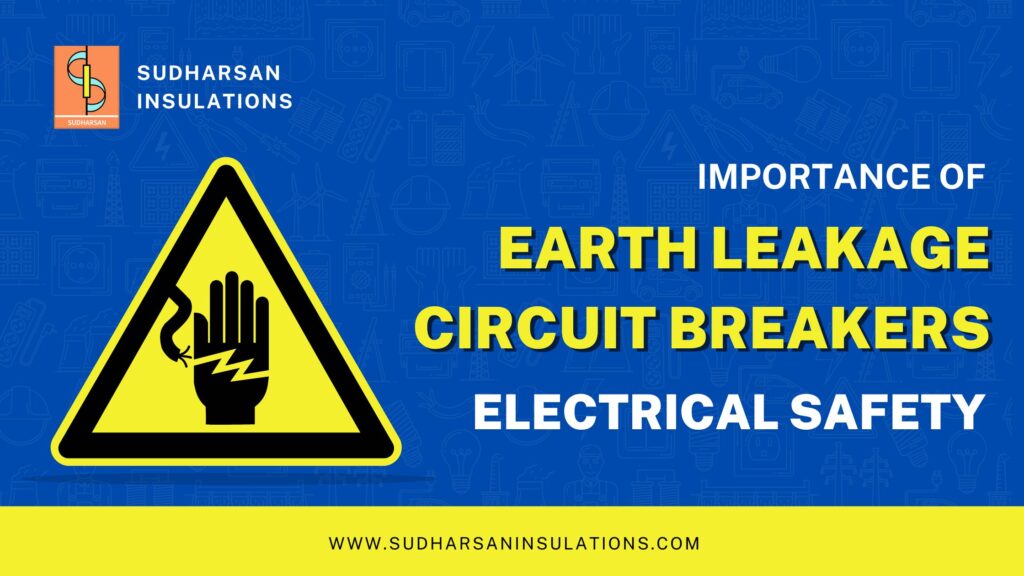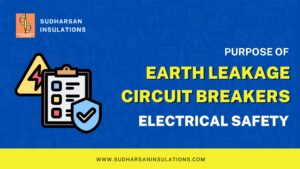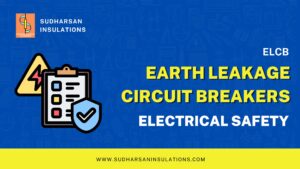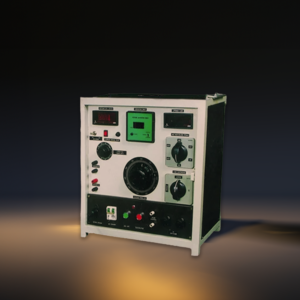Exploring Electrical Safety: The Importance of Earth Leakage Circuit Breakers (ELCBs)
Last Updated : April 1, 2024

Imagine a scenario where a simple electrical appliance malfunction could lead to a life-threatening situation. Scary, right? That’s why understanding electrical safety and the role of Earth Leakage Circuit Breakers (ELCBs) is crucial. This comprehensive guide will explore the world of electrical safety, with a focus on ELCBs – devices designed to protect you, your family, and your property from electrical hazards.
What is an ELCB (Earth Leakage Circuit Breaker)?
An Earth Leakage Circuit Breaker (ELCB) is a safety device that monitors the flow of electricity in a circuit and quickly cuts off the power supply if it detects an imbalance, indicating a potential leakage of current to the earth. The primary purpose of an ELCB is to prevent electrical shocks, fires, and equipment damage caused by earth leakages.
ELCBs work by continuously comparing the current flowing through the live and neutral wires of a circuit. In a normal situation, the current in both wires should be equal. However, if there is a leakage of current to the earth, the ELCB detects the imbalance and trips the circuit within milliseconds, effectively disconnecting the power supply.
The importance of ELCBs cannot be overstated, as they are essential safety devices in residential, commercial, and industrial settings. They provide an additional layer of protection against electrical hazards, safeguarding human lives and property.
Understanding Electrical Hazards
Common electrical hazards in homes and workplaces include:
- Faulty wiring and outdated electrical systems
- Overloaded circuits and extension cords
- Damaged insulation on wires and cables
- Exposure to moisture and water
- Improper grounding of electrical equipment
These hazards can lead to serious risks, such as electrical shocks, fires, and equipment damage. According to the National Fire Protection Association (NFPA), electrical malfunctions are responsible for an estimated 51,000 home fires each year in the United States, resulting in nearly 500 deaths, 1,400 injuries, and $1.3 billion in property damage.
Types of ELCBs and Their Applications
There are two main types of ELCBs:
Voltage-operated ELCBs
These devices monitor the voltage between the earth and the neutral conductor. If the voltage exceeds a predetermined threshold, the ELCB trips the circuit. Voltage-operated ELCBs are suitable for residential and small commercial applications.
Current-operated ELCBs
Also known as residual current devices (RCDs), these ELCBs monitor the current flowing through the live and neutral conductors. If the difference in current exceeds a set value (typically 30mA), the ELCB trips the circuit. Current-operated ELCBs are more sensitive and widely used in residential, commercial, and industrial settings.
When selecting an ELCB, consider factors such as load capacity, sensitivity, and the specific requirements of your application. Consult with a qualified electrician to determine the most suitable type of ELCB for your needs.
Installation and Maintenance of ELCBs
- Proper installation and maintenance of ELCBs are crucial for ensuring their effectiveness and reliability. Here are some guidelines:
- Always hire a qualified and licensed electrician to install ELCBs in your home or workplace.
- Follow the manufacturer’s instructions and adhere to local electrical codes and regulations during installation.
- Test ELCBs regularly (at least monthly) using the built-in test button to ensure they are functioning correctly.
- Schedule annual inspections and maintenance by a professional electrician to identify and address any issues.
- If an ELCB trips frequently, investigate the cause and consult an electrician to resolve the problem.
Remember, attempting to install or repair ELCBs without proper knowledge and training can be dangerous and may void the device’s warranty.
ELCB Regulations and Standards
Electrical safety codes and regulations vary by region and country, but most jurisdictions have mandatory requirements for ELCB installation in different settings. For example:
- In the United Kingdom, the 18th Edition of the IET Wiring Regulations (BS 7671) requires the installation of RCDs in all new domestic and commercial installations.
- In Australia, the AS/NZS 3000 Wiring Rules mandate the use of RCDs in various residential, commercial, and industrial applications.
- In the United States, the National Electrical Code (NEC) specifies requirements for GFCI (Ground Fault Circuit Interrupter) protection, which is similar to ELCBs.
Non-compliance with these regulations can result in fines, legal liabilities, and increased risk of electrical accidents.
Tips for Electrical Safety at Home and Work
Installing ELCBs, there are several steps you can take to promote electrical safety:
- Conduct regular electrical safety inspections to identify potential hazards, such as frayed wires, overloaded outlets, and outdated equipment.
- Address any identified hazards promptly, either by repairs or replacement of faulty components.
- Educate family members and employees about electrical safety practices, such as:
- Not overloading outlets or extension cords
- Keeping electrical appliances away from water
- Unplugging appliances when not in use
- Avoiding DIY electrical repairs
- Implement safety protocols and emergency procedures, including proper labeling of electrical panels and regular fire drills.
By following these tips and prioritizing electrical safety, you can create a safer environment for yourself, your family, and your colleagues.
Frequently Asked Questions about ELCBs
How long do ELCBs last?
ELCBs typically have a lifespan of 15-20 years, but this can vary depending on the manufacturer and usage conditions. Regular testing and maintenance can help prolong their life.
Can I install an ELCB myself?
No, it is strongly recommended to hire a qualified and licensed electrician to install ELCBs. Attempting to do it yourself can be dangerous and may void the device’s warranty.
Are ELCBs compatible with all electrical systems?
ELCBs are compatible with most modern electrical systems, but it’s essential to consult with an electrician to ensure the right type and size of ELCB is selected for your specific application.
How often should I test my ELCBs?
It is recommended to test ELCBs at least monthly using the built-in test button. This helps ensure the device is functioning correctly and provides the necessary protection.
Conclusion
Earth Leakage Circuit Breakers (ELCBs) play a vital role in ensuring electrical safety in homes, workplaces, and industrial settings. By understanding the importance of ELCBs, their types, and proper installation and maintenance, you can take proactive steps to protect yourself, your family, and your property from electrical hazards.
Remember to prioritize electrical safety measures, such as regular inspections, addressing potential hazards, and educating others about safe practices. If you have any concerns or questions about ELCBs or electrical safety, always consult with a qualified and licensed electrician.
Don’t wait until an accident happens to take action. Invest in the safety of your loved ones and your property by installing and maintaining ELCBs today.
Here are the key products from Sudharsan Insulation with reduced sentence length:
High Voltage Kits, Loading Transformers, Primary Current Injection Test Kit, Secondary Injection Kits, MCCB Kits, RCCB Kits.




